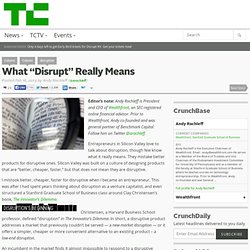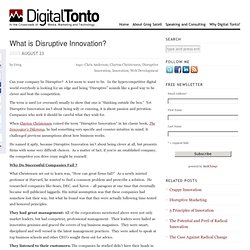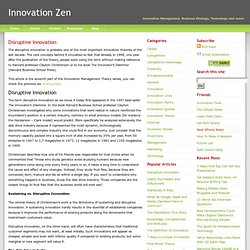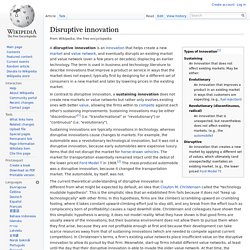

What “Disrupt” Really Means. Editor’s note: Andy Rachleff is President and CEO of Wealthfront, an SEC-registered online financial advisor.

Prior to Wealthfront, Andy co-founded and was general partner of Benchmark Capital. Follow him on Twitter @arachleff. Entrepreneurs in Silicon Valley love to talk about disruption, though few know what it really means. They mistake better products for disruptive ones. Silicon Valley was built on a culture of designing products that are “better, cheaper, faster,” but that does not mean they are disruptive. I mistook better, cheaper, faster for disruptive when I became an entrepreneur. Christensen, a Harvard Business School professor, defined “disruption” in The Innovator’s Dilemma. An incumbent in the market finds it almost impossible to respond to a disruptive product. Thus, the innovator’s dilemma. Google: Disrupting online advertising. The initial AdWords customers were startups that couldn’t afford to advertise on Yahoo. Salesforce: Disrupting CRM. What is Disruptive Innovation? Can your company be Disruptive?

A lot seem to want to be. In the hypercompetitive digital world everybody is looking for an edge and being “Disruptive” sounds like a good way to be clever and beat the competition. The term is used (or overused) usually to show that one is “thinking outside the box.” Yet Disruptive Innovation isn’t about being wily or cunning, it is about passion and privation. Companies who seek it should be careful what they wish for. When Clayton Christensen coined the term “Disruptive Innovation” in his classic book, The Innovator’s Dilemma, he had something very specific and counter-intuitive in mind. He named it aptly, because Disruptive Innovation isn’t about being clever at all, but presents firms with some very difficult choices.
Why Do Successful Companies Fail ? What Christensen set out to learn was, “How can great firms fail?” They listened to their customers: The companies he studied didn’t have their heads in the sand. A Surprising Answer - Greg. Disruptive Innovation. Some examples of disruptive innovation include: As companies tend to innovate faster than their customers’ needs evolve, most organizations eventually end up producing products or services that are actually too sophisticated, too expensive, and too complicated for many customers in their market.

Companies pursue these “sustaining innovations” at the higher tiers of their markets because this is what has historically helped them succeed: by charging the highest prices to their most demanding and sophisticated customers at the top of the market, companies will achieve the greatest profitability. However, by doing so, companies unwittingly open the door to “disruptive innovations” at the bottom of the market. An innovation that is disruptive allows a whole new population of consumers at the bottom of a market access to a product or service that was historically only accessible to consumers with a lot of money or a lot of skill. Disruptive Innovation. The disruptive innovation is probably one of the most important innovation theories of the last decade.

The core concepts behind it circulated so fast that already in 1998, one year after the publication of the theory, people were using the term without making reference to Harvard professor Clayton Christensen or to his book The Innovator’s Dilemma (Harvard Business School Press). This article is the seventh part of the Innovation Management Theory series, you can check the previous six clicking here. Disruptive innovation. Sustaining innovations are typically innovations in technology, whereas disruptive innovations cause changes to markets.

For example, the automobile was a revolutionary technological innovation, but it was not a disruptive innovation, because early automobiles were expensive luxury items that did not disrupt the market for horse-drawn vehicles. The market for transportation essentially remained intact until the debut of the lower priced Ford Model T in 1908. The mass-produced automobile was a disruptive innovation, because it changed the transportation market. The automobile, by itself, was not. The current theoretical understanding of disruptive innovation is different from what might be expected by default, an idea that Clayton M. The work of Christensen and others during the 2000s has addressed the question of what firms can do to avoid displacement brought on by technological disruption.